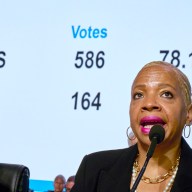OTTAWA – Just like that sinking feeling from seeing a parking ticket flapping on the windshield, government staff dread seeing a yellow or red ticket on their desks.
It means they’ve been careless with confidential paperwork and the document police have left them a warning.
Sometimes the papers are taken away, and the employee must do the walk of shame to the department’s security office to pick up their files and sign a form.
All this falls under a strict security protocol drummed into public servants and political staff when they first take their jobs.
Jasmine MacDonnell, the former director of communications for Natural Resources Minister Lisa Raitt, would have gone through a training program to introduce her to the complicated system of document security, as well as a security clearance procedure.
“When you get your first briefing on security, they’re really talking about security of information and not your physical security,” says Gar Knutson, a former junior cabinet minister in the former Liberal government.
“They spend a lot of time showing you how to deal with papers.”
MacDonnell resigned after documents marked secret were left behind at a television studio, and not noticed missing until CTV reported the gaffe a week later.
She was in the news again Monday for reportedly misplacing a tape recorder with audio of the minister on it.
One of her former colleagues on Parliament Hill dismissed her relatively young age of 26 as a factor.
“Everyone coming into these jobs knows what the ground rules are when dealing with sensitive documents,” the staffer said, pointing out that random checks are regularly done in offices to make sure paperwork is handled properly.
The Raitt case is serving as remedial course for staff across government.
For one, classified documents should be kept in a ministerial briefcase that can only be opened with a combination or key when they are taken out of an office.
Security rules also specify that ministers take as few documents with them as possible, relying only on what they absolutely need.
“Having the documents with you is a bit unusual,” said David Zussman, a longtime federal public servant now at the University of Ottawa.
“Why would you need them at a news organization – what value would they have there?”
Every department has different practices with their documents, but a decision must be made on each whether it might harm the national interest if it makes its way into the public domain.
Some documents – such as those held by the foreign affairs or public safety ministers – could potentially result in a loss of life if they got into the wrong hands.
Classified documents are ones that are deemed most sensitive, and they are stamped either CONFIDENTIAL, SECRET or TOP SECRET.
Designated documents are deemed of lower value, but are still stamped PROTECTED, and the letters A, B, or C attached to denote higher or lower levels of sensitivity.
The protocols for cabinet, federal budget or Privy Council Office documents is even more stringent, with numbers assigned to each document so that they can be tracked to individual recipients.
Tony Macerollo, one of the longest serving executive assistants of the former Liberal government, worries about “secrecy inflation.” He wonders about the sensitivity of Raitt’s documents, which appeared to be drafts of information that was about to be made public.
“In my time, the number of things that got stamped secret at the time got a little out of control,” said Macerollo, who worked alongside minister John Manley in several departments.
“It was more designed to provide you with an insurance against accidental information getting out that might be sensitive but not necessarily secret.
“The word secret was just like the word urgent – there was a tendency to debase the meaning.”
















